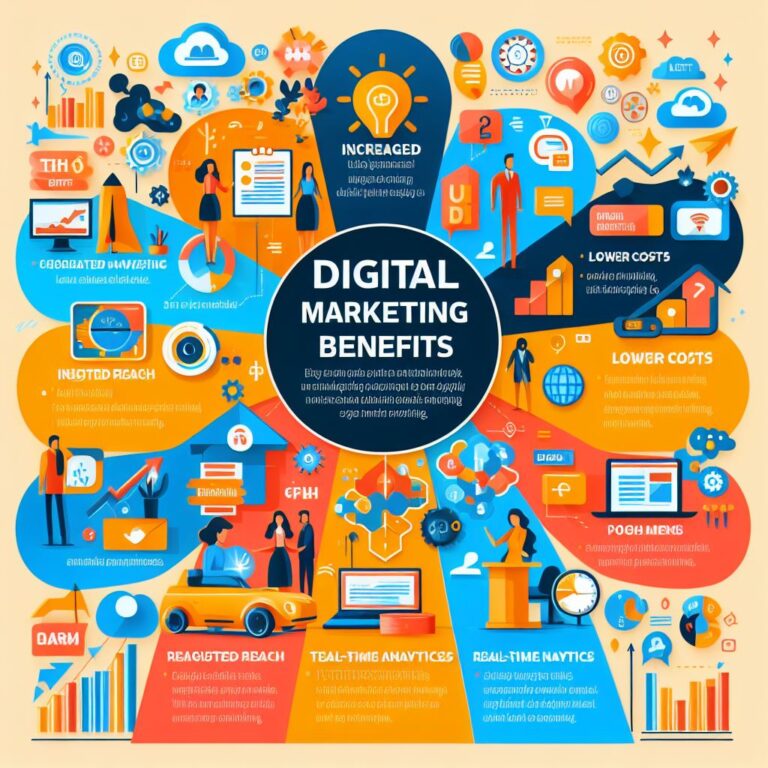What is Digital Marketing?
Digital marketing is a form of marketing that leverages the internet and digital technologies, such as computers and mobile devices, to connect with customers. More than running a sponsored Instagram ad to drive sales, it’s a set of practices that interacts with customers at every stage of the buying journey.

Digital Marketing channels:
In today’s digital world, there are various channels to conduct marketing activities.
Let’s look into different channels and what each of these channels can bring.
-
Search Engine Optimization (SEO): Optimizing your website to rank higher in search engine results pages (SERPs) organically, thus increasing visibility and traffic.
-
Content Marketing: Creating and distributing valuable, relevant content to attract and retain a clearly defined audience. This could include blog posts, articles, videos, infographics, etc.
-
Social Media Marketing: Utilizing social media platforms like Facebook, Instagram, Twitter, LinkedIn, etc., to promote products or services, engage with audiences, and build brand awareness.
-
Email Marketing: Sending targeted emails to prospects or customers to nurture leads, promote products or services, or build relationships.
-
Pay-Per-Click (PPC) Advertising: Placing ads on search engines or social media platforms where advertisers pay a fee each time their ad is clicked. Google Ads and Facebook Ads are popular platforms for PPC.
-
Affiliate Marketing: Partnering with other businesses or individuals (affiliates) who promote your products or services in exchange for a commission on sales generated through their referral.
-
Influencer Marketing: Collaborating with influencers—individuals with a large and engaged following on social media—to promote products or services to their audience.
-
Video Marketing: Using videos to promote products or services, tell stories, or engage with audiences. This can include YouTube ads, video content on social media, or live streaming.
-
Mobile Marketing: Targeting users on mobile devices through channels like SMS marketing, in-app advertising, or mobile-responsive websites.
-
Native Advertising: Creating ads that match the form and function of the platform on which they appear, making them less intrusive and more likely to be viewed by users.
-
Remarketing/Retargeting: Showing targeted ads to users who have previously visited your website or interacted with your brand online, aiming to re-engage them and drive conversions.
-
Chatbot Marketing: Using chatbots to automate customer service, provide information, or guide users through the sales funnel via messaging platforms or websites.
-
Local SEO: Optimizing your online presence to attract local customers. This includes strategies like local keyword optimization, creating and managing Google My Business listings, and getting listed in online directories.
-
Voice Search Optimization: With the rise of voice-activated devices like smart speakers and virtual assistants (e.g., Siri, Alexa), optimizing content for voice search queries is becoming increasingly important. This involves using natural language keywords and providing concise, direct answers to common questions.
-
Interactive Content Marketing: Creating engaging, interactive content such as quizzes, polls, assessments, calculators, and interactive infographics to provide value to your audience and encourage active participation and sharing.
-
Podcast Marketing: Leveraging podcasts as a marketing channel by either creating your own podcast to share industry insights and engage with your audience or sponsoring existing podcasts that align with your brand.
-
User-Generated Content (UGC) Campaigns: Encouraging your audience to create and share content related to your brand or products. This can include contests, challenges, or simply encouraging customers to share their experiences through reviews, testimonials, or social media posts.
-
Augmented Reality (AR) Marketing: Using AR technology to create interactive experiences that allow users to visualize products in their environment before making a purchase. This can be particularly effective for industries like retail, furniture, and cosmetics.
-
Virtual Reality (VR) Marketing: Similar to AR, VR technology can be used to create immersive brand experiences or virtual tours that engage and captivate users, particularly in industries like travel, real estate, and entertainment.
-
Webinars and Online Events: Hosting webinars, workshops, or virtual events to educate, engage, and connect with your target audience. These can be used for lead generation, customer education, or building thought leadership in your industry.
-
Data Analytics and Marketing Automation: Leveraging data analytics tools and marketing automation platforms to track, analyze, and optimize your digital marketing efforts. This includes measuring key performance indicators (KPIs), segmenting audiences, and delivering personalized content at scale.
-
Blockchain Marketing: Exploring opportunities to leverage blockchain technology for secure transactions, transparent supply chains, and decentralized advertising networks, which can improve trust and transparency in digital marketing efforts.
Digital marketing benefits:

- It scales easily
- It is cost-effective
- It provides a direct line to engage with your customers
- Results can be quickly and transparently measured and analyzed
- It provides an avenue for you to learn from your customers, market, and other industry players
Disadvantages of Digital marketing:

- Information Overload
- Technical Issues and Dependencies
- Privacy Concerns
- Increased Competition
- Dependence on Technology
- Difficulty in Standing Out
- Rapid Changes and Updates
- Negative Feedback Amplification
- Lack of Personal Touch
- Digital Fatigue

Hi, this is a comment.
To get started with moderating, editing, and deleting comments, please visit the Comments screen in the dashboard.
Commenter avatars come from Gravatar.